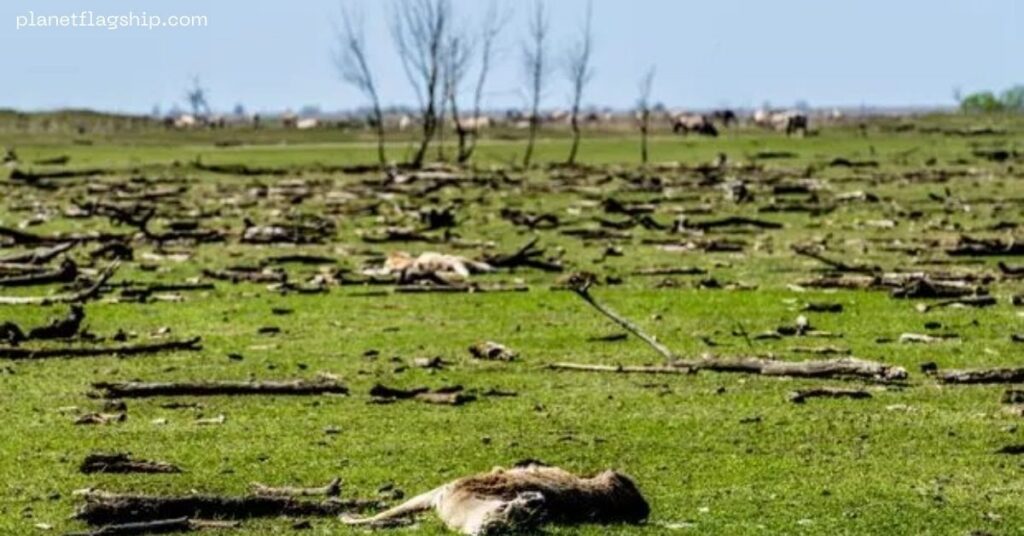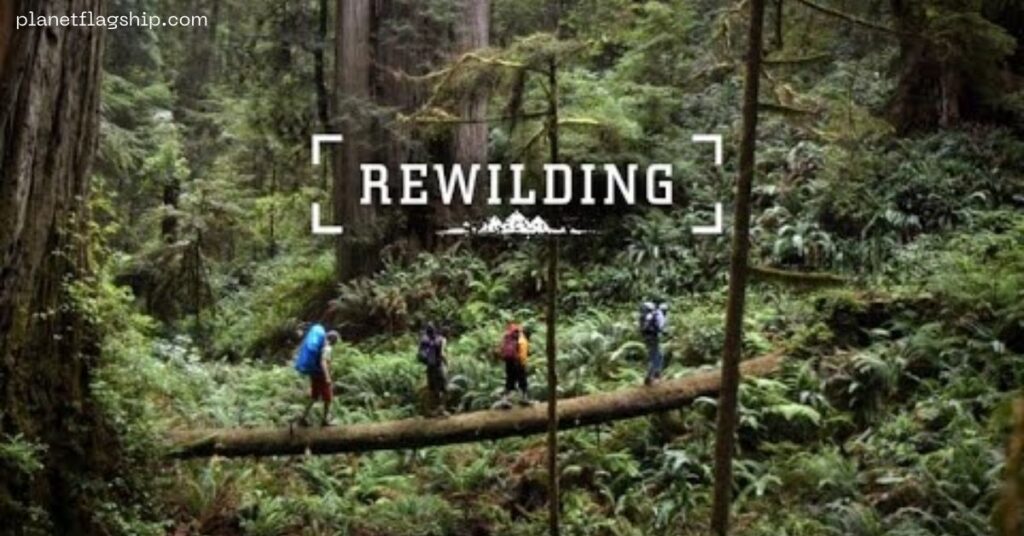Introduction
Rewilding to Save the Planet involves introducing native species into natural ecosystems and allowing nature to shape the environment. Human activities have altered landscapes and biodiversity; therefore, rewilding may be an optimistic approach to reversing environmental degradation and combating global warming.
Such an approach can help reestablish wildlife populations while enhancing ecosystem services, including carbon capture, water purification, and soil fertility. The examination includes rewilding, its environmental and social benefits, the challenges it presents, and its relationship to wider sustainability goals. Understanding the potential of rewilding allows us to assess whether large-scale restoration of nature can save the planet.
What is rewilding?
It means restoring keystone species, eliminating human-made barriers to ecosystems, & permitting ecological processes to rewild. Unlike conservation, which typically focuses on protecting habitats or species, rewilding emphasizes ecosystem resilience and self-regulation.
This might involve apex predators, large herbivores, or native plants that have been lost to human impact returning.
The Ecological Benefits of Rewilding

Rewilding offers several ecological advantages, including biodiversity restoration, ecosystem services, and a reduction in global warming. We will review these in more detail:
1. Biodiversity for Ecosystem
Health 1 and 1 Resilience rewilding may help return the species to near extinction in some habitats, thereby regaining the ecological balance. These are called keystone species, and they include predators such as wolves or lions, as well as large herbivores like bison, which control food chains and support the rest of the ecosystem.
For example, the restoration of wolves to the Yellowstone National Recreational Area in the US has dramatically disturbed the local ecology. Wolves reduced elk numbers, and vegetation recovered. That helped stabilize riverbanks 1 and 1 and improve habitat quality for beavers and birds.
2. Enhancing Ecosystem Services
Ecosystem services are the benefits that humans derive from nature, such as water purification, soil fertility, and flood regulation. By restoring natural ecosystems through rewilding, we can strengthen these services. For example, beavers create wetlands that act as natural water filters and flood regulators. Reintroducing such species to suitable areas can enhance water quality and mitigate the risk of flooding, ultimately benefiting both the environment and local communities.
READ MORE: Eco Certifications: Do They Really Mean Anything?
Rewilding and Climate Change Mitigation
Rewilding plays a vital role in climate change mitigation by restoring ecosystems that naturally sequester carbon dioxide. Forests, wetlands, and grasslands act as carbon sinks, absorbing atmospheric CO₂ and helping to offset greenhouse gas emissions. By reviving degraded landscapes, rewilding enhances biodiversity, allowing flora and fauna to thrive while improving soil health and water retention.
Additionally, resilient ecosystems can better withstand climate extremes, reducing vulnerability to droughts, wildfires, and floods. Reintroducing keystone species, such as large herbivores and predators, supports ecological balance, further strengthening nature’s ability to regulate carbon cycles. As global temperatures rise, rewilding offers a sustainable, nature-based solution to combat climate change.
Challenges to Rewilding

While rewilding holds enormous potential, it is not without its challenges. The restoration of ecosystems requires careful planning, long-term commitment, and collaboration between stakeholders. Some of the main challenges include:
1. Habitat Availability and Land Use Conflicts
In many parts of the world, habitat destruction has reached a point where reintroducing certain species may not be feasible. Urbanization, agriculture, and infrastructure development have significantly reduced the available space for wildlife.
Moreover, land use conflicts often arise, particularly when farming communities or industries are concerned about the potential risks posed by large herbivores or predators.
2. Genetic Diversity and Species Adaptability
Reintroducing species to habitats where they have been absent for centuries presents challenges related to genetic diversity. In certain instances, the reintroduction of a species may result in its populations no longer being genetically compatible with their new environment.
Additionally, species may struggle to adapt to new conditions, including a changing climate and altered food availability, after being absent from the landscape for such a long time.
3. Financial and Logistical Constraints
Rewilding projects require significant financial investment for both initial reintroductions and ongoing monitoring and management. Securing funding can be a significant challenge, particularly in areas where governments or the private sector do not adequately support conservation priorities. Long-term success depends on continuous funding, research, and support from local communities, which may not always be readily available.
Real-World Rewilding Projects
There are several notable rewilding projects worldwide that have successfully restored ecosystems and biodiversity. Some of the most successful examples include
1. The Rewilding of Europe
One of the most ambitious rewilding projects in the world is Rewilding Europe, an initiative that aims to restore large areas of wilderness across the European continent. The project focuses on reintroducing species like the European bison, wild horses, and wolves to Europe’s wilderness areas, with the goal of promoting biodiversity, ecotourism, and sustainable land use.
Through partnerships with local communities and stakeholders, Rewilding Europe has successfully restored large tracts of land to their natural state, demonstrating that rewilding can be a win-win solution for both the environment and local economies.
2. The Return of the Bison in North America
In North America, the reintroduction of bison to the Great Plains has been one of the most successful rewilding efforts. Overhunting and habitat loss drove the bison, once abundant across the continent, to the brink of extinction.
Today, reintroduction programs have led to bison populations rebounding in areas such as Yellowstone National Park and Canada’s Grasslands National Park. Bison play a vital role in maintaining grassland ecosystems by grazing and creating disturbances in the soil, which promotes plant diversity.
3. The Wolves of Yellowstone
As mentioned earlier, the reintroduction of wolves to Yellowstone National Park has had profound ecological effects. By restoring the natural predator-prey relationship, the presence of wolves has helped regulate elk populations, leading to increased vegetation growth, healthier river ecosystems, and a broader diversity of wildlife. People often cite this case study as one of the most successful examples of rewilding in practice.
Integrating Rewilding into Global Sustainability Efforts

Rewilding aligns with the United Nations’ Sustainable Development Goals by promoting environmental conservation, climate action, and the development of sustainable communities. It complements other sustainability practices by addressing environmental, social, and economic pillars simultaneously.
FAQ’s
What does rewilding really mean?
Rewilding means giving nature the space and freedom to heal itself. It’s about restoring lost species, rebalancing ecosystems, and letting natural processes thrive again. Think wolves in Yellowstone or bison on the Great Plains nature taking back its role.
How does rewilding help fight climate change?
Rewilding boosts natural carbon storage by restoring forests, wetlands, and grasslands. Healthy ecosystems absorb more CO₂, making them powerful climate allies. They also reduce risks from floods, droughts, and wildfires, protecting both people and wildlife.
What are the biggest challenges to rewilding?
Challenges include land conflicts with farming or urban use, funding shortages, and ensuring species can adapt to today’s environments. Success needs careful planning, local support, and long-term commitment to keep ecosystems thriving.
Can rewilding benefit people as well as wildlife?
Yes! Rewilding improves water quality, soil health, and flood control services humans rely on daily. It can also spark ecotourism, create jobs, and strengthen cultural connections with nature, making it a win for both communities and ecosystems.
Where has rewilding worked successfully?
Yellowstone’s wolf reintroduction, Europe’s bison comeback, and North America’s grassland restorations are great examples. These projects show how restoring keystone species brings entire ecosystems back to life and inspires global conservation efforts.
Conclusion
Rewilding offers a route to restoring that balance and tackling environmental crises. It helps biodiversity, ecosystem services & climate change mitigation by revitalizing ecosystems & their functions. However, rewilding requires thoughtful implementation that considers both local communities and broader sustainability frameworks.
For the planet to thrive, rewilding, along with other sustainable practices, can create a healthier, more resilient Earth for present and future generations. Individuals and policymakers should advocate for rewilding initiatives, conservation funding, and increased awareness to make nature’s restoration a global priority.
References
- United Nations Sustainable Development Goals (UN SDGs)
- Scientific journals on ecosystem restoration and conservation biology (e.g., Science Direct, Research Gate)
- Government and NGO reports on rewilding projects and climate mitigation
- Articles on sustainability principles and environmental benefits from FSC and IFAW sources

John is a professional blogger and passionate advocate for environmental sustainability. With years of experience exploring eco-friendly practices and green innovations, he shares insightful articles on Planet Flagship to inspire a sustainable future. John’s expertise lies in making complex environmental topics accessible and actionable, empowering readers to make meaningful changes for the planet.
